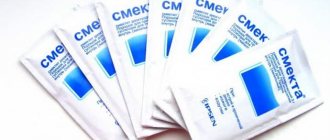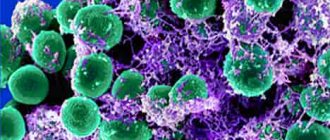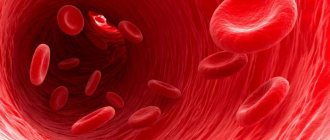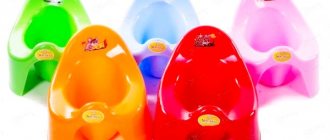Article prepared by:
Vasily Babkinsky
Doctor of the highest category
Bloody diarrhea in a child is a dangerous symptom, signaling in most cases serious problems in the gastrointestinal tract. Diarrhea itself is common in children under 5 years of age, but a symptom such as blood in the stool always frightens parents. However, not in all cases this is a reason for urgent hospitalization. The main thing is not to panic. Loose stool streaked with blood or mucus in an infant (or older child) in any case requires contacting a doctor to identify the cause and provide assistance.
Bloody diarrhea in children is a cause for serious concern
Possible causes of bloody diarrhea in a child
In a child, diarrhea with blood and mucus most often appears due to internal pathologies in the body. Sometimes this phenomenon occurs due to external factors, for example, due to nutrition or infectious diseases. That is why, as soon as parents notice diarrhea streaked with blood in their baby, they should immediately seek help from specialists.
If the reason for the appearance of such a dangerous sign lies in malnutrition, then the following factors may contribute to this:
- Poisoning from low-quality products;
- eating foods that have a laxative effect, often fruits or vegetables;
- food poisoning.
Diarrhea with mucus in a baby up to one year old is the absolute norm, since during this period the digestive tract adapts to external influences. Moreover, at this time the formation of the gastrointestinal tract occurs, which also often provokes the appearance of various impurities in the feces. However, sometimes diarrhea with blood in a baby can appear under the influence of various types of pathologies:
- Infection of the body with pathogenic microorganisms, and the source of infection can be any of the body systems.
- Infectious pathologies, which include salmonellosis, rotavirus infection, gastroenteritis, colitis and dysentery.
- Inflammatory process in the mucous membranes of the digestive tract.
- Inflammation of hemorrhoids in the rectum.
- Manifestation of allergies.
- Dysbacteriosis.
- Peptic ulcer of the stomach or duodenum.
- Lactase or other enzyme deficiency.
- Oncological neoplasms.
- Crohn's disease.
- Teething.
- Helminths.
In addition to diseases, other external factors can provoke diarrhea with mucus and blood:
- Stressful influences, strong feelings;
- entry of small parts into the stomach or esophagus, resulting in injury to the mucous membrane of the digestive tract;
- use of medicines;
- surgical intervention.
If a child has bloody diarrhea, all of the above factors must be taken into account. This is the only way to make an accurate diagnosis and prescribe the correct treatment.
Important! Parents should pay special attention to accompanying symptoms that may reveal the nature of the pathological process in the body. A child’s loose stool is unlikely to go away on its own, so you need to take measures to help the baby recover.
Possible complications
Bloody diarrhea ends with negative consequences and, even more so, death in extremely rare cases. However, you should not leave it to chance, so as not to lead to the following complications:
- loss of fluid in the body (can cause seizures or fainting),
- if even 10% of water is lost, the baby requires long-term therapy, which does not always lead to positive results,
- with a loss of 20% of water, the risk of death increases,
- intestinal problems: persistent constipation or diarrhea,
- development of lactose deficiency (if diarrhea was caused by a rotavirus infection),
- antibiotic therapy can result in dysbacteriosis,
- with untreated dysentery, the rectum may prolapse.
https://youtu.be/JDR4IJtgfss
Additional symptoms
If parents find streaks of blood in the baby’s stool, it is also necessary to pay attention to other characteristics. The color, smell and consistency of stool can tell parents a lot and help them figure out the cause of bowel problems before visiting a specialist. In addition, other signs should be taken into account:
- Blood in the stool, or more precisely, blood admixtures, is of great importance. For example, a bright scarlet color indicates that the baby has intestinal colitis or dysentery. If the blood is very dark, then the child has a peptic ulcer, which is quite rare for children at such an early age.
- The presence of an elevated temperature may also help determine the diagnosis. Diarrhea in a child without fever indicates relative safety for the baby’s body, since in this case the presence of inflammation or infection in the intestines can be immediately ruled out. A high temperature in a child and diarrhea with blood in combination indicate an intestinal infection. In addition, the child may experience general weakness and headaches, as well as sharp pain in the abdominal cavity. At this time, the baby becomes restless, constantly cries, refuses to eat and cannot sleep. The stool takes on a green tint and an extremely pungent odor.
- Diarrhea with mucus in most cases becomes a sign of rotavirus infection. Most likely, in a couple of days the baby will develop symptoms of a cold, such as a runny nose, general lethargy, fever and cough.
- If a baby's diarrhea with blood is accompanied by itching in the anus, then the baby probably suffers from internal hemorrhoids.
Parents! Before you start to panic and run to the doctor, it is recommended to carefully examine your baby’s stool.
Many parents mistake impurities of undigested food with a red pigment for bloody streaks. Beetroot often causes red stool. In addition, you need to pay attention to the general condition of the baby. If, despite loose stools and red inclusions, the child feels well, is not capricious and eats normally, most likely the digestive system is undergoing normal adaptation. You should only worry when the child cries a lot and cannot calm down.
Doctor Komarovsky's opinion
According to a famous pediatrician, diarrhea with blood is most often provoked by infection. Especially if the problem is accompanied by an elevated temperature.
The main principle is to prevent severe loss of fluid. Parents should give the baby salt solutions to drink. They are sold in pharmacies without a prescription. The most popular: Regidron or Glucosolan.
Under no circumstances should you feed your baby during the first 3-4 hours, otherwise this may lead to vomiting. Be sure to consult a doctor to correct the problem.
If your temperature rises, you should call an ambulance immediately. Before her arrival, they give an antipyretic and provide the baby with plenty of fluids.
How to provide first aid to a child?
It is highly not recommended to treat diarrhea in a child on your own. However, first aid will still need to be provided. Moreover, parents should understand what to do when such symptoms appear in order to avoid any complications:
- If you have any warning signs, you should definitely call a doctor.
- It is recommended not to dispose of feces; they will need to be shown to a doctor. Based on the nature of the stool, a specialist can draw certain conclusions regarding the cause of bowel dysfunction.
- It is advisable not to give the child food until the doctor arrives.
- Diarrhea can cause dehydration, so you should give your child something to drink every five minutes. Infants should be given water using a teaspoon.
- You can use a solution of Regidron or Oralit instead of water. The baby should be given water in small portions.
- If a child has a too high temperature of 38 degrees, you should not wait; before the doctor arrives, you need to give the child a medicine containing paracetamol. For young children, syrups or rectal suppositories are best. You should not take aspirin, as it is only approved for use by children over 12 years of age.
- It is imperative to pay increased attention to hygiene. You should wash your baby after each bowel movement.
- Of all medications, you can also use Smecta, activated carbon, Enterosgel or Polysorb. These medications are not absorbed into the blood, but on the contrary, they absorb toxic substances and remove them out.
If you don’t have Regidron or another drug in your home medicine cabinet that can restore the water-salt balance, you can prepare the solution yourself. To do this, take a liter of boiled water and cool it to room temperature. Then you need to dissolve a teaspoon of baking soda and a teaspoon of salt in water. You should also add two tablespoons of sugar and stir thoroughly. You need to give the baby the solution little by little, in small portions every 5-10 minutes.
These recommendations will help improve the baby’s condition before the doctor arrives. Moreover, such measures will help prevent complications from occurring. After a visit to the doctor, you will most likely have to undergo a full examination, take many tests, and possibly have an ultrasound. Using these procedures, the doctor will be able to confirm or rule out the presence of diseases and infections in the baby’s body.
First aid for a sick child
As soon as parents discover streaks of blood in their child’s stool, the first thing they need to do is call a doctor. What to do before the pediatrician arrives:
- Try not to feed the baby. It is not yet known why the child developed these symptoms. And it is possible that in this state, new portions of food can only worsen the course of the disease.
- Provide the child's body with enough fluid. To prevent dehydration, give your baby a little something to drink every 5-10 minutes, a few sips at a time.
- Wash your child after every trip to the toilet. Remnants of bloody diarrhea can cause irritation on delicate skin, adding to the baby's unpleasant symptoms.
- When the temperature rises above 38°C, antipyretic medications are allowed. This could be ibuprofen or paracetamol. The use of aspirin is contraindicated.
Treatment of diarrhea in children
It is possible to cure diarrhea, especially those interspersed with blood, only under the close supervision of a doctor. As a rule, the child is prescribed certain medications, depending on the cause of the diarrhea.
Also an important condition for recovery is following a certain diet. You need to give up heavy and difficult to digest foods. These products include dairy products, vegetables and fruits not processed with warm water, fried, spicy and salty foods, fatty foods, and legumes. You should include crackers and rice porridges with decoctions in your diet. These products have an astringent effect. If diarrhea streaked with blood is observed in an infant, the mother should follow the diet.
Causes
Most often, diarrhea with blood is caused by internal diseases. Less commonly, malnutrition and external factors. As soon as parents notice bloody streaks and mucus in loose stools, they need to think about what could have caused such a nuisance.
Nutrition
- Food poisoning.
- The child has eaten too much vegetables or fruits that have a laxative effect.
- Poor quality products.
Diseases
- Keep in mind that diarrhea with mucus in a child under one year old is normal, since the formation of his gastrointestinal tract is not yet complete.
- Pathogenic microorganisms in the intestines.
- Infectious diseases: salmonellosis, gastroenteritis, dysentery, rotavirus infection, colitis.
- Inflammation of the mucous membranes in the intestines, esophagus or stomach.
- Internal hemorrhoids.
- Allergic reaction.
- Dysbacteriosis.
- Ulcer.
- Enzyme or lactose deficiency.
- Cancer diseases.
- Crohn's disease.
- Teething.
- Helminths.
External factors
- Stressful situations.
- Getting into the stomach of small parts that injure the mucous membrane.
- Taking medications.
- Failed operation.
All these factors must be taken into account if a child has diarrhea with blood and mucus. They will help make an accurate diagnosis, on which treatment will depend. Before visiting a doctor, parents can conduct a preliminary examination themselves and draw a conclusion about what is happening to their baby.
Debunking the myth. It is not true that a child’s diarrhea will go away on its own; it requires qualified diagnosis and medical treatment.
Diagnostics
If there is diarrhea with blood and mucus, the child may be prescribed the following tests to clarify the diagnosis, since it can be a symptom of a variety of diseases:
- coprogram;
- stool tests for dysbacteriosis and helminths;
- general and biochemical blood tests;
- Ultrasound of the abdominal cavity.
These are the main diagnostic methods for diarrhea with blood and mucus in children, but in some cases additional studies may be prescribed depending on the situation. Once the diagnosis is confirmed, a course of treatment will be prescribed.
According to statistics. The peak of visits to the hospital with childhood diarrhea occurs in the spring-summer season.
Blood in stool is a cause for concern
A child has bloody diarrhea - should parents worry? Yes, this is a serious cause for concern. First of all, you need to pay attention to the nature of the inclusions:
- scarlet droplets;
- marks on the diaper;
- red veins;
- clots mixed with mucus;
- dark red color of feces.
The nature of the inclusions can say a lot about the baby’s health and the pathology that caused the bleeding. The most harmless, if we can say so about bloody marks, are stains on toilet paper or a diaper. Most often, they indicate microcracks around the anus due to difficulty defecating and constipation. Other inclusions require immediate medical attention.
Where does blood come from in stool?
Why does blood appear in the stool during various illnesses? The walls of the organs of the digestive system are covered with small vessels. Vessels are injured when:
For parents, the health of the child will always come first. That is why any alarming sign may be a reason to consult a doctor. An immediate reaction is required when the baby develops diarrhea with blood and mucus. These symptoms indicate serious disorders in the baby’s digestive system. In order to eliminate bloody diarrhea in a child, you must first find out the reasons for the appearance of these signs.
When to see a doctor
Bloody stool appears for various reasons. Parents do not need to panic and be very frightened, asking everyone they know and spending hours on the Internet using the search phrase “why does the child have blood in his stool.”
If the baby’s health is normal, you can observe him for several days. Perhaps the red coloring of the stool is associated with the consumption of certain foods that were in the diet of the child or mother, if the baby is on breastfeeding.
If the following symptoms are observed, you should contact a specialist immediately:
- continuous bleeding;
- bloody vomiting;
- elevated temperature;
- stomach ache;
- lack of stool for several days.
Prevention
Prevention of diarrhea with blood and mucus in children is based on proper nutrition and hygiene.
- Provide your child with quality nutrition appropriate for his age. His diet should not contain expired products, an abundance of dyes and flavor enhancers. Sausages, mushrooms, and seafood are excluded.
- Strengthen your immune system to reduce the risk of infectious diseases, which most often cause childhood diarrhea with mucus and blood.
- Maintain hygiene yourself and teach your child to do it. Berries, vegetables and fruits should be washed, as should your hands after a walk, using the toilet and before eating.
- Boil the water your child drinks.
- Forbid him from swimming in unknown bodies of water.
- Limit contact with sick people.
- Do not give up breastfeeding, but at the same time follow a diet yourself.
- Heat-treat meat, fresh milk, chicken eggs, and fish.
Childhood diarrhea with mucus and blood can be a very dangerous signal of a serious internal illness. The sooner the diagnosis is made, the faster the doctor will be able to prescribe a therapeutic course and prevent dehydration of the small body.
An experienced doctor can tell a lot about the child’s health by the appearance of the stool, its consistency, color and smell. Impurities are especially dangerous: blood, mucus, foam - they often indicate the presence of a dangerous pathology of the gastrointestinal tract. Parents should pay close attention to their baby’s discharge and consult a doctor at the first alarming symptoms. Let's look at what blood in the feces of infants and preschoolers indicates.











